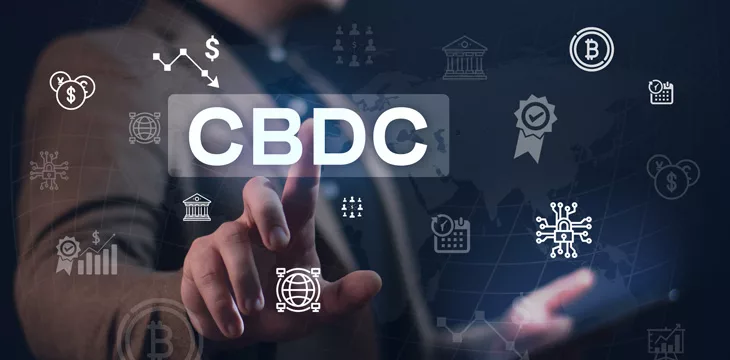|
Getting your Trinity Audio player ready...
|
We have all heard about them, mostly by media portraying them as the final arrow in the quiver of authoritarian governments hell-bent on eliminating privacy, reducing freedoms, and subjugating their subjects. At least, that is what the hype would have us all believe. But how much of that is truth, and how much is just smoke and mirrors?
In a recent The Bitcoin Masterclasses series run by Craig Wright, he focused on the practical applications of central bank digital currencies (CBDCs) while dispelling some of its common misconceptions. This article will summarize the main points of the class for those who don’t have the hours to spend watching it in its entirety. (Though it is well worth it for those who do have the inclination and time and want to know the details!)
CBDCs—the basics
Firstly, we have had CBDCs since the 70s. They aren’t themselves new; only the catchy term is. They are simply the digitization of the USD, which has been around since the adoption of electronic inter-bank communication networks. However, the CBDC system that we currently have is inefficient.
The Federal Reserve banks run the ledger itself, and the information contained within belongs to them; therefore, they can do what they please with it, including mining it for information, most infamously to enable systems of control like the Chinese social credit system, which is used to penalize people for things which they have done in order to shape behavior.
On the contrary, a CBDC system built upon the public ledger of the Bitcoin blockchain could maintain privacy while at the same time ensuring that the laws against money laundering and criminal funding can still be efficiently enforced, making it a whole better system for law-abiding folks who use it, and making it more costly for those who would use it for nefarious activities.
But how can this be done? As Dr. Wright puts it, if all personal transactions are done via blockchain, then the knowledge of which transactions belong to whom is kept private to only those parties of the transaction itself. But importantly, if someone wanted to prove something that actual transactions on the blockchain could show, they could selectively reveal (presumably through some zero-knowledge proofs) transactions that could validate the proof required of them.
Some examples of this would be proving creditworthiness by demonstrating that one has enough capital or collateral to back a loan. Another application could be to confirm whether or not one was an accredited investor by proving that a person has a provable history of investments, and trading experience, simply by running a program that would be able to scan all their trades that were committed to the blockchain using digital USD and tokenized securities.
The key point is audit-ability while maintaining total privacy by deterministically calculating key addresses from a root key linked to identity.
Take a digital identity, say a passport document, and link it to a private root key; then with appropriate wallet software, use this root key and some details of every transaction to salt the transaction to produce a unique ID that is effectively private. Only the people who know about the details of the transaction used in the salting process will be able to pinpoint the transaction in a sea of other transactions.
Transaction Versioning—one for every bank or CBDC
Dr. Wright then mentions that a much-overlooked field in the Bitcoin transaction format is the OP_VER or version flag. This is a 16-bit field that can represent 65,536 different values that could be used to mark different transaction versions, which each country’s central bank and all major banks in the world could use to have their own transaction version. Using transaction versioning, only the nodes run by the country’s bank would listen to the transactions pertinent to their own nation and run custom rules for them. This alleviates all nodes from listening to all transactions.
Some applications of this could be vehicle registration, VAT, and other automated tax collection schemes. Many government tax and licensing systems could be automated and streamlined so that software could automatically tell you when your license needs to be renewed, deduct tolls from your account when you incur them, or pay taxes automatically, perhaps even at the point of sale in the case of sales taxes.
Another more pedestrian application is instant confirmation of whether or not someone can buy a restricted item, such as cigarettes or alcohol, engage in activities such as gambling, etc. With CBDCs and instantly auditable records, these sorts of controls can be implemented easily at the point of sale, especially in e-commerce, where protecting personal information such as IDs is paramount. Streamlining these checks translates into reduced costs for necessary compliance with the rules and regulations of the state.
The other positive aspect of CBDCs is their potential to prevent the economy from getting into another financial crisis like the one we experienced in 2006. Dr. Wright mentions using CBDCs to audit all banks and financial institutions to ensure that their capital reserves are sufficient to ensure their solvency in the worst-case scenario. The current practice of taking a portfolio’s ‘mark to market’ value is flawed because it often never takes into account the feedback effect on price that the unwinding of a large position into the market would actually cause.
However, this is the current accepted best method of valuation on Wall Street, which we all now know is insufficient to model what happens when the whole economy suffers a widespread, systematic shock. The idea is that if all positions and accounts were using CBDCs on the blockchain, then complete audits of a company’s financial stability can be done, and full analysis risk modeling can be performed system-wide.
Furthermore, the secondary effects of a company going bankrupt (ahem… Lehman) or even a group of companies going bust simultaneously can be more accurately modeled, all while preserving the records’ privacy and the audit’s integrity.
No more hiding debts or booking false value on assets that don’t actually exist or are illiquid.
But all this talk of deep intrusive sounding audits certainly scares a lot of people and privacy watchdogs out there, given the potential for these tools to be used by a draconian government to unduly spy on their citizens or otherwise oppress their civil liberties.
This is certainly a concern that we should be wary of and watchful of. At the end of the day, any tool, just like the common knife or gun, can be turned into a tool for oppression as easily as it can be a tool for freedom. The onus is on us to keep a watchful eye on those who would use them and ensure that lawmakers do not abuse their powers. The argument is that the benefits of a transparent, fully auditable money system far outweigh the potential downsides.
I, for one, think that counter-intuitively, a CBDC would actually make for the eventual relaxing of strict laws and penalties against money launderers and tax evasion. Why? Simply because I believe that the current laws and systems put in place are much more harsh than they need to be in order to act as a deterrent to those who may want to be considering breaking a law. Because governments lack cost-efficient ways to actually enforce these laws, they simply account for a certain percentage of people getting away with petty crimes and lawbreaking and increase the penalties on those they actually catch to act as an example for others.
With a simple way of making the enforcement of regulations and policies regarding money in place, many of the laws and penalties put to act as deterrents could eventually be unnecessary and be abolished.
At the end of the day, if we have a money system that has public, transparent, and auditable rules, then we can finally envision a system that is equitable to all, rich or poor, young or old. Indeed, this is how we really reach the unbanked of the world and include them in the global economy.
To learn more about central bank digital currencies and some of the design decisions that need to be considered when creating and launching it, read nChain’s CBDC playbook.
Watch: Deploying CBDCs on the original Bitcoin

 12-22-2025
12-22-2025 




